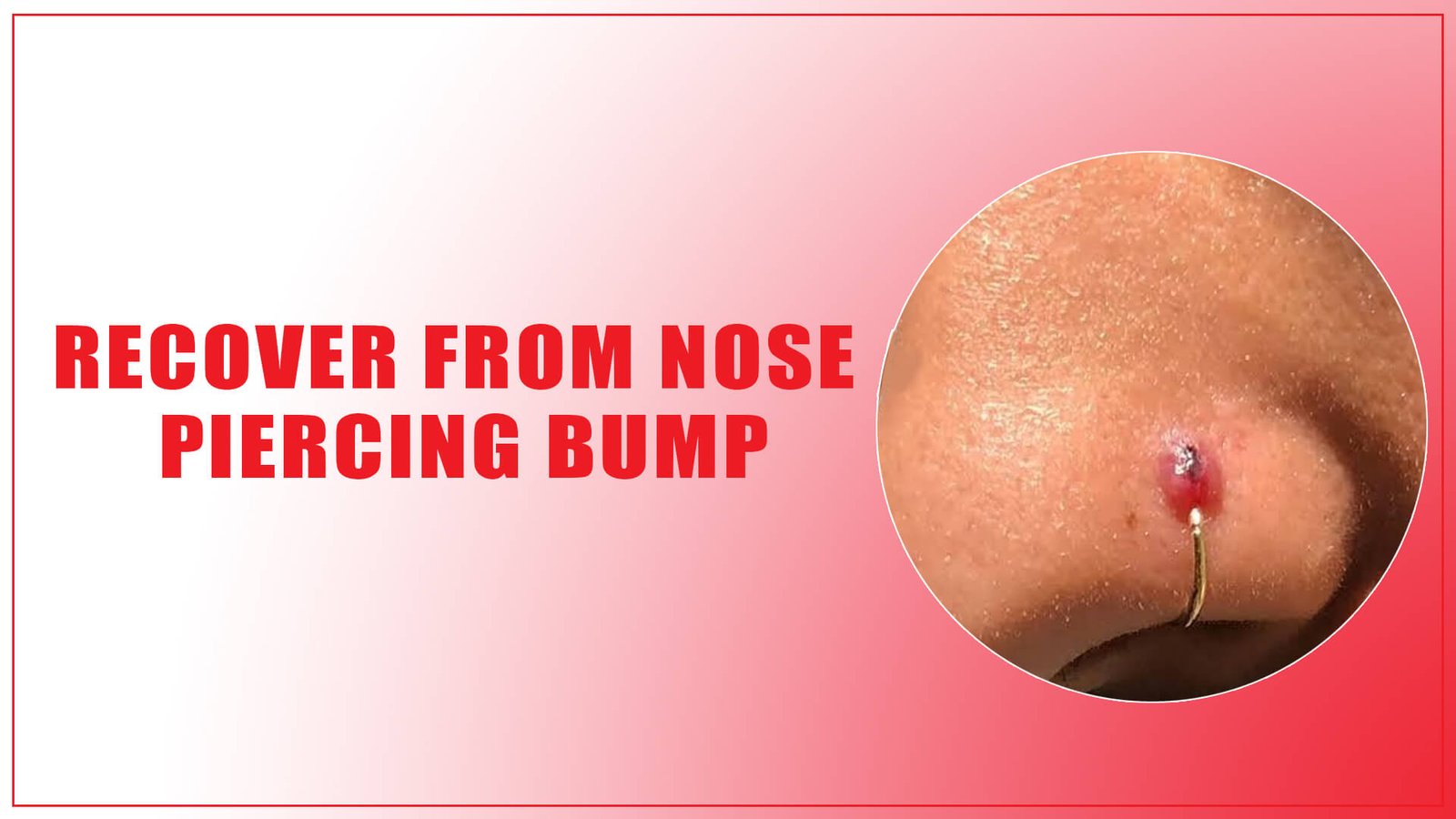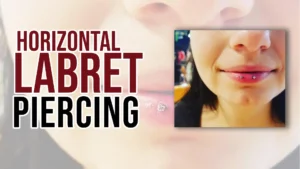When you suddenly see a red bump pierced on your nose, it appears beautiful and fancy. You attempt to sleep it off in the hope that it will go off the next day, but lo and look, it’s still there.
You wait for another day, and as you look in the hand mirror, much to your horror, you see a bright red bump looking back at you. How can it be managed to get rid of? Can you dispose of your nose’s ugly red raised bump?
What exactly is the Bump?
It’s normal to have bruising, bleeding, redness, and swelling for a few weeks after getting your nose pierced. You will suffer discomfort in the area, white pus that oozes from the location, and a crust that forms over your nose piercing while the area heals.
According to doctors, your nose piercing would take roughly six months to heal entirely. However, you should let your piercer know if the symptoms increase. Suppose you can see a bump developing at the piercing site. A lump could be a concern.
Causes of Nose Piercing Bump
You shouldn’t be concerned about your nose piercing if your piercer used sterilized tools and if you strictly followed their aftercare instructions. It should fully recover in a few months.
The following things may contribute to the production of the bump at the piercing site:
- If the piercing is removed too soon, tissue injury may result.
- If the area where the piercing occurred is unsanitary, an infection could develop.
- Your nose ring causes an allergic reaction in you.
- The fluid that is trapped at the piercing site takes the form of a lump or mound.
- You get a raised or keloid scar (keloids look darker than the rest of your natural skin)
- a bump-shaped granuloma or inflammatory tissue
A red bump on your nose can occur because of other factors, such as:
When to get immediate medical attention
Signs of a more serious disease include:
- An uncomfortable level of discomfort, throbbing, or heat at the piercing site, even if minor swelling and redness are common.
- unexpected pain at the piercing site
- An unpleasant odor with pus escaping from the piercing site that is green or yellow
Don’t remove your jewelry if any of these factors are visible. By causing the piercing to close when you take off your jewelry, you risk retaining harmful bacteria at the piercing site. It can occur in a more serious infection.
You must visit your piercer straight away. They will provide advice for appropriate treatment and offer their expert assessment of your symptoms.
Keep reading for five ideas on how to treat a bump from a nose piercing if you don’t have any of these more severe symptoms.
Five Ways to Get Rid of Nose Piercing Bump Easily:
Depending on what created a bump from a nose piercing, there are many ways to remove it. Continue reading to learn about some helpful home treatments.
1. Always Clean Your Nose Piercing Daily:
Typically, new piercings need to be cleaned two to three times every day. You can get a more detailed suggestion from your piercer.
Always wash your hands well with warm water and liquid soap before handling your nose piercing for any reason. Therefore, after using a paper towel to dry your hands, take care of your piercing.
You can use particular cleansers that your piercer can suggest. They’ll advise against cleaning your piercing with soaps that include triclosan because they can dry up the skin around it. For the first six months, you should clean the piercing every day. The tissue from inside your nose may still be recovering even if the piercing appears to be healed from the outside.
Aftercare procedures should prevent any tissue damage or infections that can result in a bump. The piercer should advise on how to take care of a piercing, which typically includes cleaning it often.
2. Use hypoallergenic jewelry
Certain metals, mainly nickel or an alloy (a metal and also another element), can cause allergic reactions in some people. It can be an allergy if a red, itchy rash develops if the piercing is consistently painful.
Hypoallergenic jewelry that won’t react with the body should be used instead of jewelry producing an allergic reaction.
Jewelry made of an appropriate material, such as titanium or surgical steel, should be used by reputable piercers.
3. Cleanse with a sea salt soak
- If your piercer didn’t suggest a specific soap, you should clean your piercing with a salt solution. Make your solution by adding 8-10 ounces of warm water with 1/4 teaspoon of non-iodized sea salt.
- Soak a paper towel in the salt solution next. Hold the wet paper towels over your nose piercing for five to ten minutes. Warm clothes are what are used to soften any crust or discharge around your piercing. It might sting a little.
- To keep the area warm, you might want to reapply a fresh piece of wet paper towel every two minutes or sodium.
- After applying the compress, carefully clean the inside and outside of your nose piercings of any moist crust or discharge using a clean cotton bud dipped in the salt solution.
- A fresh piece of paper towel can alternatively be soaked in the salt solution and squeezed over the affected area to rinse it.
- Dry the area off using a fresh piece of paper towel.
- Two or three times a day, repeat this technique.
4. Use a chamomile compress.
Chamomile contains substances that accelerate wound repair and improve skin barrier repair. Using just a salt solution and a chamomile solution can be alternated.
How to prepare a hot chamomile compress
- Prepare a cup of tea as you normally would by soaking a chamomile tea bag in it.
- Wait for 3 to 5 minutes as the bag steeps.
- Apply the chamomile solution to a piece of paper towel and leave it on your piercings for 5 to 10 minutes.
- Soak a fresh piece of paper towel and reapply it about every two minutes to maintain the heat.
If you have an allergy to ragweed, then you shouldn’t be using chamomile.
5. Apply diluted tea tree essential oil
Natural antifungal, antiseptic, and antimicrobial agents include tea trees. Tea tree oil is particularly effective in drying a bump from a nose piercing. Additionally, its quality services provided prevent infection and reduce inflammation.
But take care: Reactions to tea tree oil are possible. Before applying it to an open wound, such as a nose piercing, when it is your primary use, do a patch test.
To perform a patch test:
- Apply a very small amount of diluted tea tree oil on your forearm.
- Hold off until at least 24 hours.
- You can apply this solution to your nose piercing if you wouldn’t suffer any irritation or discomfort.
Simply combine two to four drops of oil with around 12 drops of carrier oil, such as almond, olive, and coconut oil, to create a tea tree solution. Tea tree oil will be reduced by the carrier oil, allowing it to apply to your skin.
Preventing a bump
Infections or cell damage, which are typically easy to avoid, are the two main causes of nose-piercing bumps. You have to follow these terms to prevent it in the future.
- Going to a respected piercing studio will assist ensure that a nose piercing is done safely and without infection by a skilled professional in a safe environment.
- To assist people in selecting a piercer they can depend on, the Association of Professional Piercers keeps a list of member businesses.
- The piercing should be kept clean by frequently changing bedding and pillowcases, cleaning hands before touching the area, and cleaning it with a saltwater or sea salt solution twice a day.
- When possible, people should refrain from knocking, twisting, or adjusting the nose piercing. They should also be careful not to remove the jewelry until the tissue has fully healed.
Final Verdict:
As quickly as you become notice a bump at your piercing site, evaluate it. Is it anguishing? Is pus coming forward from it? The best action to take is to inform your piercer if the symptoms get worse over time. Additionally, if you use the proper cleaning solution and are disciplined to clean the site every day, you can prevent nose-piercing bumps.
FAQs:
Are piercing bumps on the nose considered normal?
In most cases, piercing bumps are caused by the body’s normal healing process after an injury. People can, therefore, take precautions to keep the area clean, prevent infection, and let the piercing heal. These include leaving piercing jewelry in for at least six weeks without altering or removing it.
Do bumps from nose piercings go away?
Typically pinkish, reddish, or even blackish-brown in color, these soft lumps ooze or bleed readily. Granulomas typically disappear on their own, so just don’t be a concern. If you keep a close eye on it for a few days or perhaps a week.t should be fine as long as it stays little.





